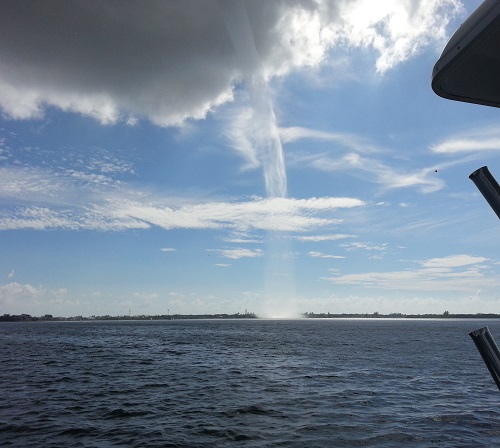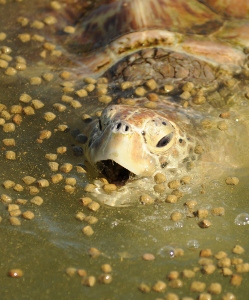 Science and Nature
Science and Nature

200 vets converge in Cayman for conference
 (CNS): Some 200 animal doctors from all over the Caribbean and from the United States will be visiting the Cayman Islands this week as the local Veterinary Medical Association (CIVMA) hosts the 28th Biennial Caribbean Veterinary Medical Association (CbVMA) Conference at the Marriott Beach Resort. This event is the leading forum for veterinarians from the region Caribbean and this year’s theme is “Opening New Frontiers in Veterinary Medicine: The Work, The Life, The Balance”. Organisers said the ultimate goal is to improve both animal and human quality of life. The agriculture minister Kurt Tibbetts will officially open the conference tomorrow and Guy Harvey, is the Keynote Speaker at the event that will include practical wet labs and master classes. For more information visit www.cbvma.org
(CNS): Some 200 animal doctors from all over the Caribbean and from the United States will be visiting the Cayman Islands this week as the local Veterinary Medical Association (CIVMA) hosts the 28th Biennial Caribbean Veterinary Medical Association (CbVMA) Conference at the Marriott Beach Resort. This event is the leading forum for veterinarians from the region Caribbean and this year’s theme is “Opening New Frontiers in Veterinary Medicine: The Work, The Life, The Balance”. Organisers said the ultimate goal is to improve both animal and human quality of life. The agriculture minister Kurt Tibbetts will officially open the conference tomorrow and Guy Harvey, is the Keynote Speaker at the event that will include practical wet labs and master classes. For more information visit www.cbvma.org
Airport depends on air cannon to scare away birds
(CNS): With an early start to the migration season and an abundance of feathered visitors this year, the Cayman Islands Airports Authority (CIAA) is firing its air cannon more frequently than usual to prevent wildlife strikes to aircraft. This year has been very busy, with an abundance of cattle egrets, great egrets, stilts and swallows in the area around Owen Roberts International Airport. The Zon Gun Propane Cannon better known as the “air cannon” is a commonly used piece of equipment that keeps birds away without harming them or interfering with air traffic but officials said that people are complaining about the noise.
The blasts are generated by propane gas that causes a popping noise that scares the birds away.
At recent working group meeting about the problem of birds around the airport CIAA’s senior manager for safety management systems Andrew McLaughlin said the authority was doing all it could to keep wildlife, from interfering with operations and keep a safe operating environment at the Airport.
“Wildlife strikes can not only be catastrophic, but they also cost the airport industry billions of dollars in damages each year, therefore it’s a major concern for the CIAA.”
Due to the increase in wildlife, CIAA has extended the hours of deployment of the air cannon, which has caused some complaints from the public. “While we apologize for the inconvenience, the air cannon serves a higher purpose in maintaining the safety of aircraft operations.”
CIAA also plans on posting signs along the airport fence to alert motorists about the use of the air cannons for wildlife management. The goal is to ensure all passing motorists and residents in the area are made aware of the cannons so they won’t be alarmed by the sound.
CIAA is also encouraging the public to do its part to help prevent wildlife strikes by informing airport staff about wildlife, covering trash cans, picking up garbage and not feeding the birds in the areas surrounding the airport.
Happy Hour on the rocks after stormy night
(CNS): The stormy night caused something of a hangover for a local pleasure cruiser after the vessel broke from its moorings Friday. The ‘Happy Hour’ was washed up on the rocks in downtown George Town during Friday night's localised storm. Although other vessels were also believed to have had a bad time, according to Hazard Management, there were no other reports of any significant damage to property during the nighttime drenching. According to the latest forecast, Cayman can expect more turbulent weather over the next few days as a stationary front to the east spreads in and out of our area during the next 24 hours.
Meanwhile, the remnants of TD9 has turned into Tropical Storm Hannah off the coast of Nicaragua, though it is not expected to pose any threat to the Cayman Islands.

Local weather still unsettled as TD9 fades away
 (CNS): A tropical depression that was expected to strengthen into a tropical storm weakened Wednesday evening as it passed over Mexico’s Yucatan Peninsula. But local weather remains inclement with heavy showers and cooler conditions expected around Cayman, as a result of another weather system in our area which will bring more unsettled conditions for the next few days. Local weather experts predict possible flooding in low lying areas at the weekend. Forecasters state that the remnants of TD9 may still become an organized tropical system again once it reaches the Caribbean Sea which could also impact Cayman.
(CNS): A tropical depression that was expected to strengthen into a tropical storm weakened Wednesday evening as it passed over Mexico’s Yucatan Peninsula. But local weather remains inclement with heavy showers and cooler conditions expected around Cayman, as a result of another weather system in our area which will bring more unsettled conditions for the next few days. Local weather experts predict possible flooding in low lying areas at the weekend. Forecasters state that the remnants of TD9 may still become an organized tropical system again once it reaches the Caribbean Sea which could also impact Cayman.
Wild green turtle poached from WB beach
(CNS): Poachers are believed to have illegally taken a nesting green turtle from a beach in West Bay. While on patrol recently the Department of Environment (DoE) Chief Conservation Officer Mark Orr said he discovered signs that the adult female was dragged off when she came onto the beach to lay eggs. “This incident was discovered on 6 October,” he said, adding that it was not an isolated incident. “This summer, DoE volunteers also discovered parts of a slaughtered loggerhead turtle in North Side. We don't believe these are isolated incidents; we believe other, undetected incidents have also taken place.”
The DoE also said that results from new and ongoing research show the urgency of reducing the illegal take of green turtles from Cayman's small nesting population as there is evidence that significant numbers of the endangered wild marine creature are being poached.
Research involves a night-time tagging project, funded by the UK Darwin Initiative and launched in June 2014, and a daytime beach monitoring programme that began in 1999. DoE Research Officer Dr Janice Blumenthal said there are serious concerns about the population despite the increase in nest numbers since 1999, when daytime monitoring of beaches in Grand Cayman started.
“We've seen an increase from a low of only one nest in 1999, to a high of 181 nests in 2012,” she said.
While the daytime monitoring establishes the number of nests each year, it only provides one side of the story – it does not allow a precise determination of the number of females nesting. This is where the tagging of turtles proves useful.
“The true number of turtles nesting each year in Grand Cayman was unknown until the Department began its Darwin-funded, night-time tagging programme,” Dr Blumenthal said. “We know that the 131 green turtle nests found in Grand Cayman so far this year were not laid by 131 turtles. Our challenge was to tag and individually identify nesting green turtles to determine how many females laid these nests,” she added.
By cross referencing the new night-time tagging data with information gleaned from the department's longstanding daytime monitoring efforts, the DoE is now refining estimates of the number of green turtles in the nesting population, and better estimating the contribution of the Cayman Turtle Farm to wild nesting populations, with the goal of protecting nesting turtles. The purpose of the daytime monitoring is to establish the number of turtle nests laid each year, in order to indicate population trends.
Female green turtles can each lay up to six nests per season; and they typically nest every two to three years, rather than every year.
DoE staff and volunteers tagged 21 green turtles in 2014 and, while the research is ongoing, preliminary results suggest that these turtles represent the vast majority of this year's green turtle nesting population, with each turtle laying up to six nests. This indicates that the illegal take of turtles poses a serious problem, because the overall population size is extremely low.
“It's clear from our preliminary results that populations are even smaller than previously thought, and thus more vulnerable to threats such as illegal take,” Dr Blumenthal warned.
Losing even one turtle means six fewer nests – and, as turtles lay more than 100 eggs per nest, this means 600 fewer eggs in that turtle's nesting year. This reduction affects the population for every year that the turtle could have continued to nest.
Orr said that, because of the very low numbers of nesting turtles on our beaches, DoE considers illegal take of turtles to be one of the most serious conservation offences. Past cases of this nature have resulted in fines and prison sentences, and any equipment including vehicles and boats used in the offence may be confiscated by the courts. Anyone with information regarding illegal take of turtles is asked to make a report to Mark Orr by calling 916-4271; 911; or Crime Stoppers at 800-TIPS.
Tropical depression stirring up local weather
(CNS): A tropical depression which is currently meandering over the southern Bay of Campeche is expected to become a tropical storm today as it begins to move eastwards. TD9, likely to be Tropical Storm Hanna is almost stationary but it will begin moving soon weather experts say. Heading slowly towards the Cayman area the late season weather system is already stirring things up for miles around. The cyclone winds are currently at 35 mph and although it is expected to strengthen then weaken as it passes over the Yucatan Peninsula, when it moves back over the warm Caribbean waters it is expected to strengthen again bringing more inclement weather to Cayman over the weekend.
According to the NHC in Miami the storm will be passing south of Cayman on Monday. In the meantime, the local weather report states that moderate southeast winds and seas are expected over the Cayman Islands for the next 24 hours in association with the low pressure over the southwest Gulf of Mexico. Radar images show, north westward moving scattered showers around the Cayman area.

Large waterspout spotted off airport runway
 (CNS): A CNS reader captured an impressive image of a waterspout that had formed on the North Sound just off the Owen Roberts International Airport runway, Saturday. Fortunately there was no aircraft taking off at the time. Although not an uncommon weather phenomenon around Cayman this was a particularly large example of an intense columnar vortex. Waterspouts are non-supercell tornadoes, less powerful than land tornadoes and connected to towering cumuliform cloud or cumulonimbus cloud. Photo by Ian Hider
(CNS): A CNS reader captured an impressive image of a waterspout that had formed on the North Sound just off the Owen Roberts International Airport runway, Saturday. Fortunately there was no aircraft taking off at the time. Although not an uncommon weather phenomenon around Cayman this was a particularly large example of an intense columnar vortex. Waterspouts are non-supercell tornadoes, less powerful than land tornadoes and connected to towering cumuliform cloud or cumulonimbus cloud. Photo by Ian Hider

Turtle expert calls for change at CTF
 (CNS): A leading marine turtle specialist has waded in on the debate about the Cayman Turtle Farm and the need to transition the controversial facility from supplying meat to genuine conservation. Marydele Donnelly, currently the director of international policy at the Sea Turtle Conservancy who has worked as a conservation advocate for more than 30 years said the farm poses a threat to the Cayman economy and the conservation of wild green sea turtle populations. Donnelly who was also the program officer at the IUCN Marine Turtle Specialist Group and director of the Sea Turtle Conservation Program for the Ocean Conservancy has co-authored a paper about the farm with Dr Neil D’Cruze, from World Animal Protection and Rachel Alcock.
(CNS): A leading marine turtle specialist has waded in on the debate about the Cayman Turtle Farm and the need to transition the controversial facility from supplying meat to genuine conservation. Marydele Donnelly, currently the director of international policy at the Sea Turtle Conservancy who has worked as a conservation advocate for more than 30 years said the farm poses a threat to the Cayman economy and the conservation of wild green sea turtle populations. Donnelly who was also the program officer at the IUCN Marine Turtle Specialist Group and director of the Sea Turtle Conservation Program for the Ocean Conservancy has co-authored a paper about the farm with Dr Neil D’Cruze, from World Animal Protection and Rachel Alcock.
D’Cruze has been spearheading the WPA campaign to transform the turtle farm after the UK based animal rights charity exposed a catalogue of problems at the farm. In the new scientific paper published by the Journal of Agricultural and Environmental Ethics entitled “The Cayman Turtle Farm: Why We Can’t Have Our Green Turtle and Eat it Too.” Focuses on the concerns that by supplying meat the farm is perpetuating and promoting the consumption of this endangered species.
“I am proud to have worked on such an important research paper which highlights the threats that the Cayman Turtle Farm poses to both the Cayman economy and the conservation of wild green sea turtle populations, “ Said Donnelly. “Our arguments are clear: the millions of dollars ploughed intothe Cayman Turtle Farm each year could be much better spent on protecting green sea turtles in the wild, using tried and tested methods which have been shown to yield real results.”
The WPA campaign, launched in 2012, has already highlighted severe animal welfare concerns associated with the Farm which is now the place in the world which raises endangered sea turtles for meat. This new paper adds conservation concerns to the growing list of rationale for why the Cayman Turtle Farm cannot carry on with its current mode of operation. The authors put forward the case that sea turtle farming comes at an astronomic economic cost.
The paper reiterates the WPA’s call for the Farm to transition into a sea turtle rehabilitation center that fully protects the animals in its care. The authors cite the example of Kelonia on Réunion Island, a facility which has successfully and profitably transitioned from a commercial sea turtle farm to a rehabilitation and education facility.
This new research paper also echoes some of the findings in the recent Ernst & Young report which recommends significant operational change at the Cayman Turtle Farm as it sucks some $10million a year from the public purse.
“World Animal Protection was delighted to read the findings of the recent Ernst & Young report,” Said D’Cruze. “It echoes the findings contained within our new scientific paper for the Journal of Agricultural and Environmental Ethics.”
The WPA also revealed that the Cayman Islands Government has still not formally responded to the charity after it had engaged in talks with the WPA over potential changes at the farm as well as a survey conducted by the DoE about the level of demand for the meat.
“We once again urge the Cayman Islands Government to take an objective look at this growing body of evidence and to transition away from sea turtle farming as a conservation tool,” D’Cruze said.
The scientific paper can be downloaded here:
Lawyers help out Magic Reef Recovery project
(CNS): As volunteers, local dive companies and the department of the environment continue the painstaking work to try and save the reek which was crushed by a cruise ship anchor recently, they were joined last week by a group of local lawyers. Taking time from their billable hours eight Appleby staff members swapped their business suits for dive suits and joined Off the Wall Divers to help recover live coral dislodged by the anchor during the devastating destruction of the reef in August. Now dubbed the Cayman Magic Reef Recovery project it will run for several months as divers continue removing rubble from some 12,000 sqft of reef and then try to reattach the remaining live coral.
Over 8,000 pounds of rubble has already been removed from the damaged reef since the restoration project began more than four weeks ago.
“Filling and carrying the crates of rubble at depths of 60 feet and deeper is slow moving, but soon the reef will be in a state where reattaching rescued coral to the reef using marine epoxy can begin,” said Traci Brummet, from Appleby, who organised the firms’ volunteers. “The benefits of everyone’s efforts won’t be realised for some time to come but we’re delighted to have been involved in such a worthwhile project. The determination seen from other divers and dive operations, who are also volunteering their time and resources, is amazing.”
Bryan Hunter, the firm’s managing partner said he was delighted that his staff were able to make a positive contribution to the recovery project. “Volunteering enables our employees to contribute their time, knowledge and skills to make a difference in the community we live in.”
Appleby also thanked Thomas Shropshire of Off the Wall Divers for donating his time, boat and dive equipment.
Moon halo captured by CNS reader
(CNS): Wednesday’s full moon was captured with a splendid halo around it last night by a CNS reader. These types of lunar rings are caused by high-level cirrus clouds or ice crystals reflecting moonlight in the sky. Said to predict storms or bad weather, according to the US weather service, almost 65% of such moon rings are followed by rain. The halos happens when moonlight is refracted through ice particles in the Earth's atmosphere. As light passes through these hexagon-shaped ice crystals, it is bent at a 22 degree angle, creating a halo 22 degrees in radius. (Photo by Trudyann Duncan)